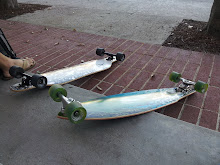I just read some Edward Hall for class (which basically confirmed that this whole idea of Systems and Cultures that I had is certainly not original, but whatever), and thought I'd use him to talk about something I'd been thinking about this trip. How movements in a city differ depending on the technologies in place to control movement, or acceptable culture that allows individuals to bend laws that are supposed to restrict movement. The comparison? Hong Kong vs. New York City.
Hong Kong has these fences everywhere, lining the streets, separating the road from the sidewalk. I get that it's for safety, to make sure people don't get hit by cars. But it's so...restrictive. I can't cross the street when and where I like. I can only cross it where the architects of the city allow me to (which could be two blocks from where I need to be, and then I would need to double back). Here, movement works in a very specific way.
New York, on the other hand, is a chaos of movement where lines on the street are mere suggestions, and a hand indicating STOP at the crosswalk gets largely unnoticed. That is, if one even crosses at a crosswalk. Here, movement works in a specific way as well. One that is very different than in Hong Kong.
To use Edward Hall's terms of formal, informal, and technical levels of culture, movement in these two cities reside in different parts of Hall's Major Triad paradigm. In Hong Kong, movement is largely determined and pre-determined by the HK Powers That Be. It resides in the "formal" level of Hall's paradigm. HK places these architectural structures in place that act as persuasive technologies to encourage people - nay, force them, to move in certain ways. You can't physically move in a way that the HK PTBs don't want you to, unless you jump the fence, and honestly, that takes more effort than is worth.
New York, on the other hand, has a formal structure (of crosswalks, lights, intersections, etc), yet no one follows it. The culture of movement in NYC depends on the informal process of learning what is acceptable by watching other people move around the city (or, more often than not, being carried with the flow). Although I'm fairly sure jaywalking is illegal, I've jaywalked in front of police cars in NYC without a second thought. There is a certain amount of leeway allowed in the formal element of the law that governs movement through a city, where the informal culture makes bending these formal laws ok.
Try doing this in HK, and I guarantee a ticket, or at least some sort of negative ramification. And Hong Kong has escalators. Talk about technology forcing you in a certain direction. Ever try running down an escalator that's heading up? Not only is it scary, it's bad for your knees, and you'll probably lose.
Oh, another place where movements are disciplined are airports and airplanes. When I'm on an airplane, I feel like I'm one of those humans in Wall-E, where I sit in a chair, and food and drinks get brought to me, and I have entertainment on a little screen right in front of me. This is what I have to look forward to for the next 12 hours. Yippee.
Grad school gets dangerous when everything you learn starts becoming very visceral. That's when it gets harder and harder to live in the world.
Subscribe to:
Post Comments (Atom)




No comments:
Post a Comment